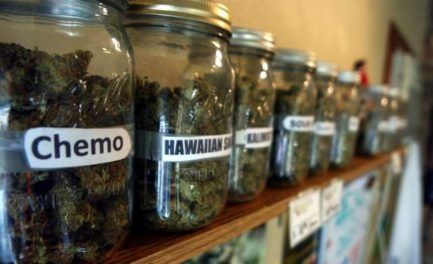Legal cannabis industry continues to struggle in California
by Chris Reed | February 26, 2019 11:36 am
 The drumbeat of disappointment over the slow start of legal marijuana in California keeps building with many dispensary owners, growers and local and state elected officials bewailing the robust health of the illegal cannabis black market.
The drumbeat of disappointment over the slow start of legal marijuana in California keeps building with many dispensary owners, growers and local and state elected officials bewailing the robust health of the illegal cannabis black market.
Last week, state officials released[1] the official tally of tax revenue in sales, excise and cultivation taxes in 2018 – the first year recreational cannabis sales were allowed under Proposition 64[2]. The $345.2 million was about a third of what most outside analysts expected. Quarterly tax revenue gained steadily until the last three months of 2018, when it flattened out.
From a basic economics perspective, this is no surprise. Illegal sellers who are often lightly policed can offer marijuana for at least 20 percent less because they don’t have to pay taxes or regulatory fees or state-mandated packaging costs. Many illegal storefront dispensaries and delivery services don’t have to worry about start-up costs. They belong to long-established networks for buying and selling marijuana that emerged after state voters’ 1996 approval of medicinal marijuana use.
But the state’s Cannabis Advisory Committee is growing impatient with the reasons authorities and others give for the enduring strength of black market sales. In the committee’s first annual report, it decried what it called the “fragmented and uncoordinated” law enforcement response to the marijuana black market. The committee’s other big gripe is the slowness of local governments to allow recreational cannabis sales. Only about one-third of cities and counties have approved such sales, according to the Southern California News Group’s database.
While Gov. Gavin Newsom said recently that he will deploy 150 California National Guard troops to eradicate illegal growing in Northern California, he has otherwise long counselled patience. On the campaign trail in 2016 while running for governor, he said he thought it would take “five to seven years” for the legal recreational marijuana industry to settle in and thrive if Proposition 64 passed. This long view is reflected in his proposed 2019-2010 budget. It anticipates $355 million in cannabis tax revenue – only a 3 percent increase from the 2018 calendar year.
Tribes, cartels could pose threat to regulated CA pot
But the industry could have other headaches on the horizon as well. A recent analysis[3] in the San Diego Union-Tribune noted some large marijuana seizures at the border in Imperial and San Diego counties that suggest Mexican drug cartels still see cannabis as lucrative even though in recent years they have largely focused on more easily imported drugs like opioids and methamphetamine.
“We are continuing to see more marijuana production in Mexico than we might expect with [California’s] legalization,” University of San Diego professor David Shirk told the newspaper.
The Mexican government has taken initial steps toward legalizing[4] cannabis. That could have fallout for the Golden State by encouraging more pot farming in Mexico.
But there’s also one emerging wild card facing California’s recreational industry that state regulators don’t appear to have anticipated: That’s the possibility that Native American tribal lands not subject to state or federal laws could emerge as both cannabis cultivation and sales centers. Tribes could potentially enjoy a price advantage over legal shops that illegal sellers now do.
A recent Southern California News Group story[5] noted that 24 state tribes, mostly in Southern California, had taken steps of varying degrees toward getting into the marijuana business. The Santa Ysabel tribe in northeast San Diego County reportedly already employs about 100 people in its cannabis greenhouses.
- released: https://www.dailybreeze.com/2019/02/19/california-made-345-million-not-predicted-1-billion-on-legal-cannabis-in-2018/
- Proposition 64: https://ballotpedia.org/California_Proposition_64,_Marijuana_Legalization_(2016)
- analysis: https://www.sandiegouniontribune.com/news/marijuana/sd-me-marijuana-black-market-20190210-story.html#nt=outfit
- legalizing: https://www.latimes.com/world/mexico-americas/la-fg-mexico-marijuana-2018-story.html
- story: https://www.ocregister.com/2019/02/14/could-cannabis-be-the-new-gambling-for-native-americans-so-far-tribes-are-being-shut-out/
Source URL: https://calwatchdog.com/2019/02/26/legal-cannabis-industry-continues-to-struggle-in-california/